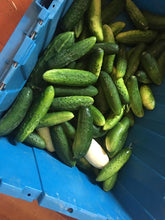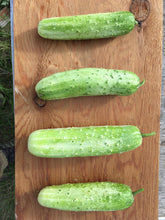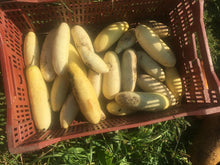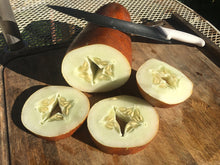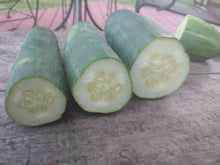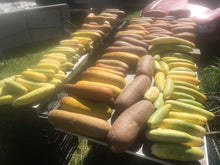'Bhutan-Meets-Greg' Cucumber Grex
Regular price
$3.50
Sale
Cucumis sativus
Origin: Minnesota/Bhutan
Improvement status: Grex/Breeding material
Seeds per packet: ~35 ($3.50)
Germination tested 11/2023: 99%
Life cycle: Annual
In our ongoing effort to offer diverse populations of use to plant breeders (amateur or professional), as well as home gardeners and market farmers, this "grex" (a term originally used by orchid breeders to describe a complex interbreeding population) is composed of at least 8-10 varieties. The base is a grex created by Minnesota organic farmer Greg Reynolds which he developed for his own use to sell to customers. He recalls that it originated with 6-8 varieties, including a white slicer, and his selection efforts through the years have focused on early-producing plants (as the Minnesota climate requires). In 2019, EFN co-founder Dusty Hinz and our colleague Zach Binsfeld grew out Greg's cucumber grex in close proximity to our favorite Bhutanese heirloom — the giant, mildew-resistant 'Gagon', which we got years ago from a USDA seed bank and has since become quite popular — and the Poinsett 76, a green slicer bred by a collaborative of East Coast researchers, able to stand up to the heat and humidity of places like Virginia and South Carolina. Since bees and other polllinators were free to transfer pollen between varieties, this new grex is likely to produce lots of interesting plants. No doubt some will be self-pollinated 'Gagon' and 'Poinsett 76', but most will be unique combinations. 'Gagon' is a decidedly funky cucumber — similar to the more commonly available 'Poona Kheera' variety from India — in that the fruit looks like a normal cucumber when immature, but soon grows in to a giant, lizard-skinned, yellow-to-red/brown beast. The mature cucumber can reach close to two feet in length, at which point it seems like an entirely different fruit, somewhat like a melon or squash. The flesh can be eaten raw, cooked in savory dishes, sweetened for dessert applications, turned into a fine chutney or soft pickle, or juiced for smoothies. We're very interested to see what crosses between 'Gagon' and more standard cucumbers look like. We hope that the earliness of Greg's grex combined with the later, longer-season productivity of the 'Gagon' and 'Poinsett 76' will make for a population well-suited to most any climate in North America. If you are interested in breeding cucumbers, one packet of these seeds should provide everything you need to get started, or if you simply want a wide spectrum of resilient, tasty cucumbers, this grex is a great choice.
We grew this grex out again in 2020 and liked the vigor and diversity of the plants that presented themselves. We decided to then combine the 2019 lot and 2020 lot into a new 50/50 batch. The 2020 lot just likely had more crossing happening. This is a good mix!
GROWING TIPS: Direct seed after danger of last frost or transplant healthy plant starts after danger of last frost. Plants should be 12-16 inches apart. If you're trellising, rows could be 4-5 feet apart. If you're letting them sprawl, rows could be 5-7 feet apart. Prefers full sun.







